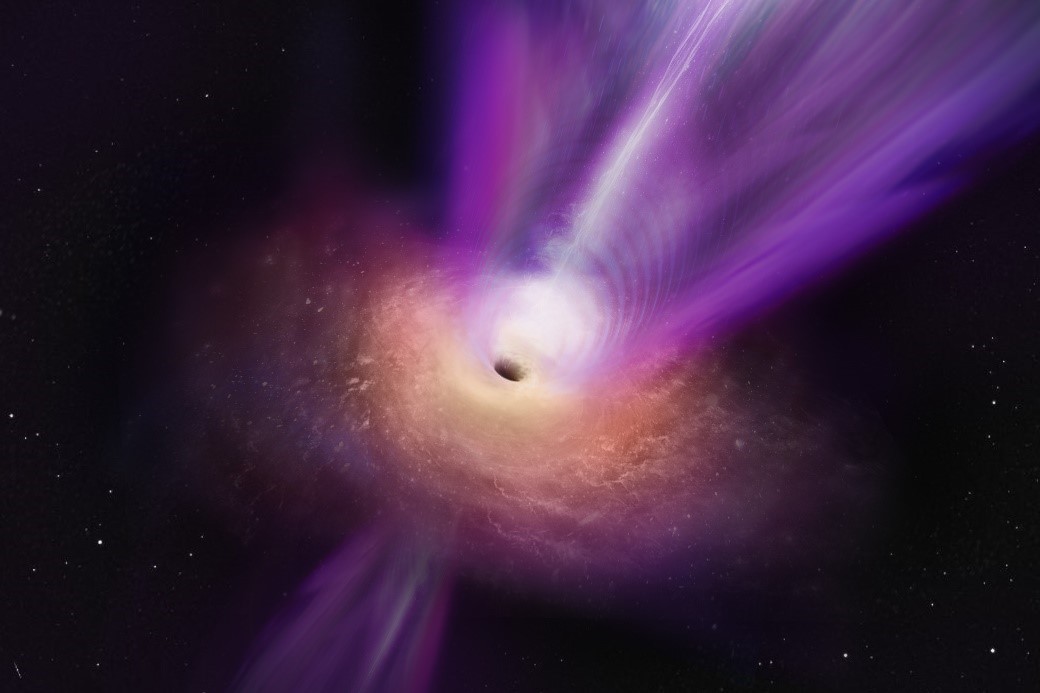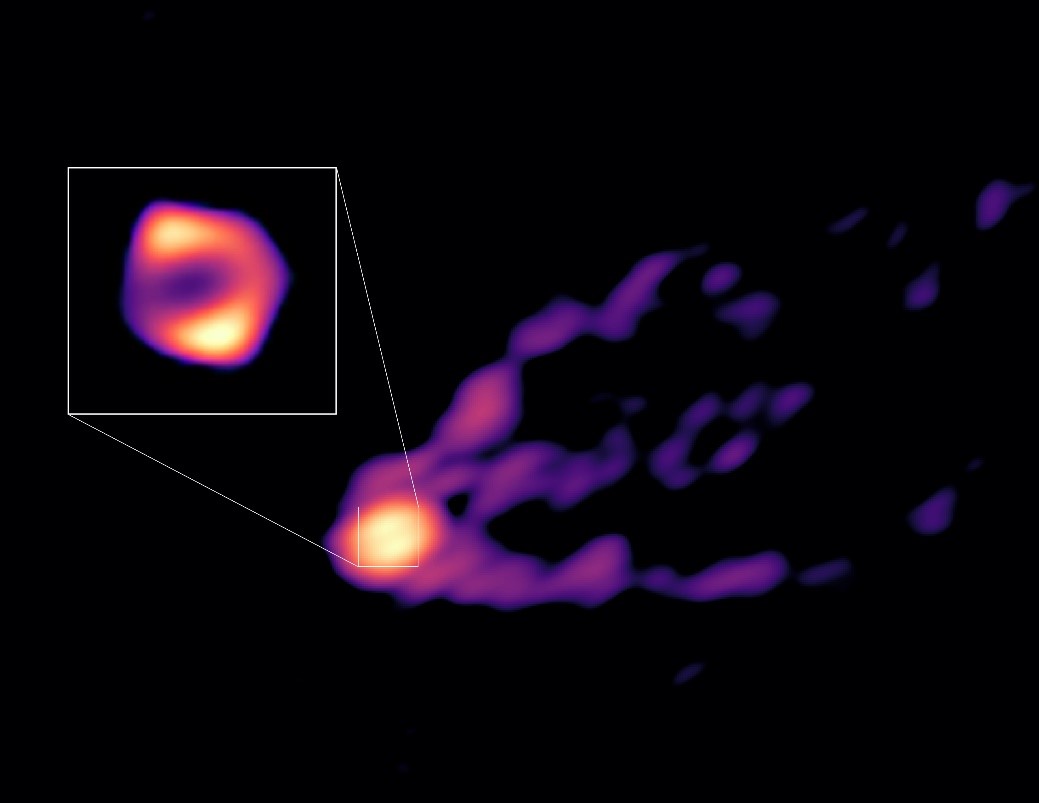An international team of scientists led by Dr. Ru-Sen Lu from the Shanghai Astronomical Observatory (SHAO) has used new millimetre-wavelength observations to produce an image that shows, for the first time, both the ring-like structure that reveals the matter falling into the central black hole and the powerful relativistic jet in the prominent radio galaxy Messier 87. The image underlines for the first time the connection between the accretion flow near the central supermassive black hole and the origin of the jet. The new observations were obtained with the Global Millimetre VLBI Array (GMVA), complemented by the phased Atacama Large Millimetre/submillimetre Array (ALMA) and the Greenland Telescope (GLT). The addition of these two observatories has greatly enhanced the imaging capabilities of the GMVA. The results are published in the current issue of Nature.
“Previously we had seen both the black hole and the jet in separate images, but now we have taken a panoramic picture of the black hole together with its jet at a new wavelength”, says Ru-Sen Lu, from the Shanghai Astronomical Observatory and leader of a Max Planck Research Group at the Chinese Academy of Sciences. The surrounding material is thought to fall into the black hole in a process known as accretion. But no one had ever imaged it directly. “The ring that we have seen before is becoming larger and thicker at 3.5 mm observing wavelength. This shows that the material falling into the black hole produces additional emission that is now observed in the new image. This gives us a more complete view of the physical processes acting near the black hole”, he added.
The participation of ALMA and GLT in the GMVA observations and the resulting increase in resolution and sensitivity of this intercontinental network of telescopes has made it possible to image the ring-like structure in M87 for the first time at the wavelength of 3.5 mm. The diameter of the ring measured by the GMVA is 64 microarcseconds, which corresponds to the size of a small (5-inch/13-cm) selfie ring light on earlth as seen by an astronaut on the Moon. This diameter is 50 percent larger than what was seen in observations by the Event Horizon Telescope at 1.3 mm, in accordance with the expectations for the emission from relativistic plasma in this region.
“With the greatly improved imaging capabilities by adding ALMA and GLT into GMVA observations, we have gained a new perspective. We do indeed see the triple-ridged jet that we knew about from earlier VLBI observations,” says Thomas Krichbaum from the Max Planck Institute for Radio Astronomy (MPIfR) in Bonn. “But now we can see how the jet emerges from the emission ring around the central supermassive black hole and we can measure the ring diameter also at another (longer) wavelength.”
The light from M87 is produced by the interplay between highly energetic electrons and magnetic fields, a phenomenon called synchrotron radiation. The new observations, at a wavelength of 3.5 mm, reveal more details about the location and energy of these electrons. They also tell us something about the nature of the black hole itself: it is not very hungry. It consumes matter at a low rate, converting only a small fraction of it into radiation. Keiichi Asada of Academia Sinica, Institute of Astronomy and Astrophysics explains: “To understand the physical origin of the bigger and thicker ring, we had to use computer simulations to test different scenarios. As a result, we concluded that the larger extent of the ring is associated with the accretion flow.”
Kazuhiro Hada from the National Astronomical Observatory of Japan adds: “We also find something surprising in our data: the radiation from the inner region close to the black hole is broader than we expected. This could mean that there is more than just gas falling in. There could also be a wind blowing out, causing turbulence and chaos around the black hole.”
The quest to learn more about Messier 87 is not over, as further observations and a fleet of powerful telescopes continue to unlock its secrets. “Future observations at millimetre wavelengths will study the time evolution of the M87 black hole and provide a poly-chromatic view of the black hole with multiple colour images in radio light,” says Jongho Park of the Korea Astronomy and Space Science Institute.
Figure 1: This artist’s conception shows a close-up view of the accretion flow and the jet emerging from the black hole region in Messier 87.
Credit: Sophia Dagnello, NRAO/AUI/NSF.
Figure 2: Millimeter-VLBI image of the jet and the black hole shadow in Messier 87, obtained with the GMVA array plus ALMA and the Greenland Telescope.
Credit: R.-S. Lu (SHAO) and E. Ros (MPIfR), S.Dagnello (NRAO/AUI/NSF)
Figure 3: Map of the radio telescopes used to image Messier 87 at 3.5 millimetres in the 2018 Global Millimetre VLBI Array (GMVA) campaign.
Credit: Helge Rottmann, MPIfR.
******
This research has made use of data obtained with the Global Millimeter VLBI Array (GMVA), which consists of telescopes operated by the Max-Planck-Institut für Radioastronomie (MPIfR), Institut de Radioastronomie Millimétrique (IRAM), Onsala Space Observatory (OSO), Metsahovi Radio Observatory (MRO), Yebes, the Korean VLBI Network (KVN), the Green Bank Telescope (GBT) and the Very Long Baseline Array (VLBA).
ALMA construction and operations are led by ESO on behalf of its Member States; by the National Radio Astronomy Observatory (NRAO), managed by Associated Universities, Inc. (AUI), on behalf of North America; and by the National Astronomical Observatory of Japan (NAOJ) on behalf of East Asia. The Joint ALMA Observatory (JAO) provides the unified leadership and management of the construction, commissioning and operation of ALMA.
The Greenland Telescope (GLT) retrofit, rebuild, and operation are led by the Academia Sinica, Institute of Astronomy and Astrophysics (ASIAA) and the Smithsonian Astrophysical Observatory (SAO).
The Green Bank Observatory (GBT) and the National Radio Astronomy Observatory (VLBA) are major facilities of the National Science Foundation, operated under cooperative agreement by Associated Universities, Inc.
The data were correlated at the Max Planck Institute for Radio Astronomy (MPIfR), which also operates the Global Millimeter-VLBI Array (GMVA).
******
Original publication
R.-S. Lu et al., A ring-like accretion structure in M87 connecting its black hole and jet, Nature, April 27, 2023, doi:10.1038/s41586-023-05843-w
******
Contact information:
Dr. Ru-Sen Lu
Shanghai Astronomical Observatory
Chinese Academy of Sciences, Shanghai
Mail: rslu@shao.ac.cn


